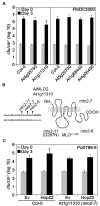Quantitative Interactor Screening with next-generation Sequencing (QIS-Seq) identifies Arabidopsis thaliana MLO2 as a target of the Pseudomonas syringae type III effector HopZ2
- PMID: 22230763
- PMCID: PMC3320541
- DOI: 10.1186/1471-2164-13-8
Quantitative Interactor Screening with next-generation Sequencing (QIS-Seq) identifies Arabidopsis thaliana MLO2 as a target of the Pseudomonas syringae type III effector HopZ2
Abstract
Background: Identification of protein-protein interactions is a fundamental aspect of understanding protein function. A commonly used method for identifying protein interactions is the yeast two-hybrid system.
Results: Here we describe the application of next-generation sequencing to yeast two-hybrid interaction screens and develop Quantitative Interactor Screen Sequencing (QIS-Seq). QIS-Seq provides a quantitative measurement of enrichment for each interactor relative to its frequency in the library as well as its general stickiness (non-specific binding). The QIS-Seq approach is scalable and can be used with any yeast two-hybrid screen and with any next-generation sequencing platform. The quantitative nature of QIS-Seq data make it amenable to statistical evaluation, and importantly, facilitates the standardization of experimental design, data collection, and data analysis. We applied QIS-Seq to identify the Arabidopsis thaliana MLO2 protein as a target of the Pseudomonas syringae type III secreted effector protein HopZ2. We validate the interaction between HopZ2 and MLO2 in planta and show that the interaction is required for HopZ2-associated virulence.
Conclusions: We demonstrate that QIS-Seq is a high-throughput quantitative interactor screen and validate MLO2 as an interactor and novel virulence target of the P. syringae type III secreted effector HopZ2.
Figures




References
Publication types
MeSH terms
Substances
LinkOut - more resources
Full Text Sources
Other Literature Sources
Molecular Biology Databases

